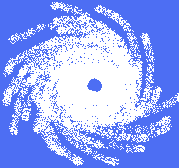| Category 3 Hurricane (SSHS) | |
|---|---|

| |
| Hurricane Daniel at peak intensity | |
| Formed | July 8, 2009 |
| Dissipated | July 16, 2009 |
| Highest winds | 1-minute sustained: 125 mph (205 km/h) |
| Lowest pressure | 940 mbar (hPa); 27.76 inHg |
| Fatalities | None |
| Damage | None |
| Areas affected | None |
| Part of the 2009 Biolixi Ocean hurricane season | |
Daniel was the fourth named storm, second hurricane, and first major hurricane of the 2009 Biolixi Ocean hurricane season. Daniel's duration was between July 8 and July 16. Daniel had maximum sustained winds of 125 mph and minimum pressure of 974 mbar. Daniel as an incredibly large category 3 hurricane that formed far from land. It was the second largest tropical cyclone ever recorded, only behind Hurricane Kameron of 2007. Daniel formed from the Tropical Cyclone Formation Axis where most strong tropical cyclones develop in the Biolixi Ocean. Once the disturbance gained enough strength, it was dubbed Tropical Depression Four by the National Hurricane Center. Four strengthened into Tropical Storm Daniel on July 9. From there, Daniel continued to strengthen at a very surprising rate and continued to increase in size. On July 12, Daniel gained its peak intensity of 125 mph and became the second largest tropical cyclone on record. No deaths or damage from Daniel were reported, due to the system remaining far from land.
Meteorological History[]

Daniel's Path
On July 5, a tropical disturbance developed along the Tropical Cyclone Formation Axis. The tropical wave slowly organized over time and and began to enter an increasingly favorable environment. On July 8, the large tropical disturbance developed into Tropical Depression Four. Four slowly moved towards the east and gradually strengthened as it moved over warmer waters. On July 9, Four strengthened into Tropical Storm Daniel with 45 mph winds. Daniel continued on its path to the east and gradually intensified. On July 10, Daniel fully developed into the season's second hurricane as it began to curve to the east-northeast. Daniel then began to increase in size due to gaining access to a warm moisture flow to its southwest. Daniel gradually drew in the moisture which added on to its outer bands, increasing the hurricane's size. Daniel became the fifth largest tropical cyclone on record after strengthening into a category 2 hurricane on July 11. Daniel was predicted to become the world's largest tropical cyclone on record if it became any stronger than a category 4 hurricane. On July 12, Daniel became the season's first major hurricane with 115 mph winds. After becoming a stronger system, Daniel increased in size and became the world's second largest tropical cyclone on record. On July 13, Daniel gained its peak intensity of 125 mph and minimum pressure of 940 mbar. Afterwards, Daniel gradually weakened and decreased in size. On July 14, Daniel weakened into a category 1 hurricane after meeting much colder waters. On July 15, Daniel weakened into a tropical storm, and then a tropical depression during the evening hours. During the afternoon hours, Daniel dissipated. The only reported impacts from Daniel were very strong surf and dangerous rip currents.
Records[]
As Daniel strengthened into a category 3 hurricane on July 12 and was announced the world's second largest tropical cyclone on record, only behind Hurricane Kameron of 2007. Daniel was only 55 miles smaller in diameter than Kameron. Daniel was an extremely large 729 miles across, which is about the size of the entire states of San Francisco and Gulf combined. Hurricane Kameron was 784 miles across, but unlike Daniel, effected land. Kameron caused some strong impacts to the Biolixi Islands as it past to the northwest of them. The only reports from Daniel were high surf and strong rip currents along coastal areas.
See also[]
- Hurricane Kameron (2007)
- 2009 Biolixi Ocean hurricane season